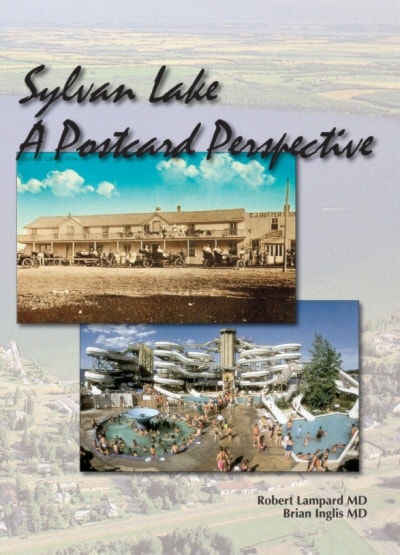Frolicking on the beach and in the water, early water slides and teeter totters, Sylvan Lake’s beginnings, the various piers, other beachfront areas and buildings of the past are just a few of the subjects depicted in a fascinating addition to Sylvan Lake’s history.
Sylvan Lake, A Postcard Perspective has just been published by medical doctors Brian Inglis and Robert Lampard.
Containing 201 postcards, along with information on scenes they depict, the book is the result of years of deltiology (postcard collecting) by the pair. The book is divided into 15 chapters. Among the subjects are early postcards, the village and town, Centennial Street and Lakeshore Drive, the second Sylvan Lake hotel, boat house, regattas and piers, sailboats and motor launches, recreation, sunsets, camps and cabins and aerial and panoramic views. The Norell, a passenger boat that took visitors on excursions around the lake from 1932 to the 1970s, is featured in its own chapter.
Inglis began his medical practice in Sylvan Lake 37 years ago. He displayed postcards in his office and solicited comments, slowly building the largest collection of Sylvan Lake postcards.
Three years ago he envisioned a book of those cards as a Centennial project for 2013 and enlisted Lampard to assist in putting it together.
“It was an opportunity to present the history of Sylvan Lake from the perspective of the many visitors who came to the lake to holiday, to enjoy its beauty, participate in water activities − and then send postcards to their friends and family,” states biographical notes in the book.
Lampard said his interest in postcards started with a chat about 20 years ago when Inglis discussed his interest in postcards and postmarks, particularly of Sylvan Lake.
“I started collecting and giving them to him as Christmas presents,” said Lampard. Then he starting collecting postcards on his own. “They’re absolutely fabulous pieces of information.”
His postcard collection now matches his book collection − he’s written eight other books, primarily on medical history of Alberta and has used postcards as illustrations in those books.
While Inglis has been here since the 1970s, Lampard has been coming to a family cabin at Sylvan Lake since the early 1940s when visitors far exceeded the town population in the summer.
In gathering information for their book, the two were able to find three other people who had postcard collections that highlighted Sylvan Lake.
Fred Freschette had a unique collection of tin reflection type postcards from the turn of the last century. They’re featured in the first chapter of the book, the earliest dated from 1900 taken from the CNR tracks looking north down main street.
Colleen Dunnigan, who has family roots here, had the second best collection after Brian’s, said Lampard.
Then Jack McCuaig of Edmonton, shared a couple of postcards with them. He has an eye for unusual postcards and is a very knowledgeable collector, said Lampard. “His interest is in who took the pictures and how many were made. The two he provided were by Byron Harmon, a famous Banff photographer.
The book’s forward notes they’ve uncovered over 220 different pre-1975 postcards, including three new and unique Sylvan Lake Picture Postcards found on e-Bay in the months preceding publication.
The book, Lampard said, “is quite a different history. It reflects the visitors. It’s very summer focused, very water focused, reflects a very vibrant community in the summer time.” One of the cards noted Sylvan Lake was the third most popular summer resort in the province, something that’s borne out by the number and variety of cards created.
They were only able to find one postcard of a winter scene which shows ice pushed up on the shore. The inscription states “Savan Lake” which they’ve interpreted to be Sylvan Lake, although there are no distinguishing features in the picture.
One of the more active locations in the community during the summer was Varsity Hall, but they were unable to find a postcard of that building.
Many of the cards they have are also void of handwritten messages on the back since they weren’t mailed.
“From my point of view this was a delightful trip to take down memory lane,” said Lampard. “To recall experiences of a younger time in my life. Everybody came to the beach in summers, the same people every year, we made lots of friends. There was unparalleled activity, especially for people living in Sylvan Lake.”
Lampard added that they continue to acquire postcards, particularly Brian with the Sylvan Lake theme. “If anyone else has cards, we would be interested to know, be happy to see them.”
Sylvan Lake & District Archives research staff, particularly Marion Thompson, were very helpful with the book, said the authors. They also relied on historic research on articles about Sylvan Lake from early copies of Red Deer News, Red Deer Advocate, Sylvan Lake News and is forerunners, transcribed by Steve Dills of Sylvan Lake News and available at the archives.
They’ve deposited digital copies of all the postcards with the archives for future study.
A limited quantity of 250 books were printed and are available from the authors − Dr. Brian Inglis at 403-887-7037 (brianinglis@telus.net) or Dr. Robert Lampard at 403-346-0331 (j.robert.lampard@gmail.com) for $25 each.
For more on Lampard’s other books check his website at www.robertlampard.ca. Besides medical history, he has written a book on Rotarian James Wheeler Davidson who is credited with starting Rotary in Australia and New Zealand.
